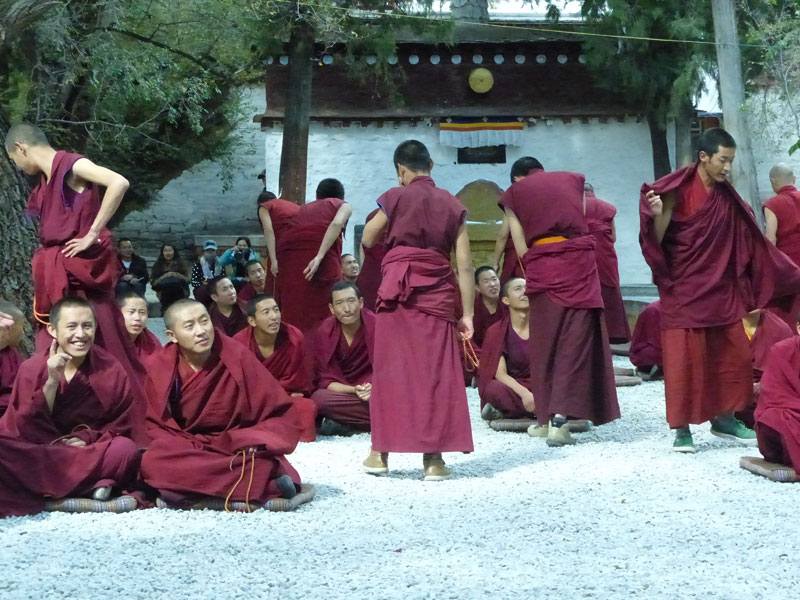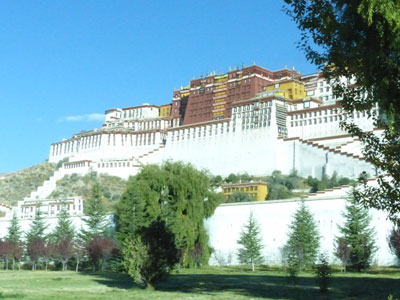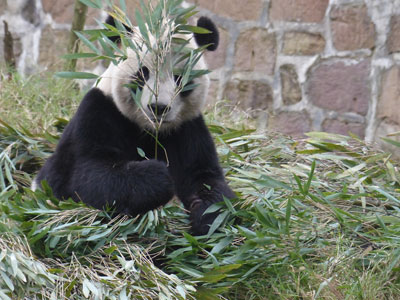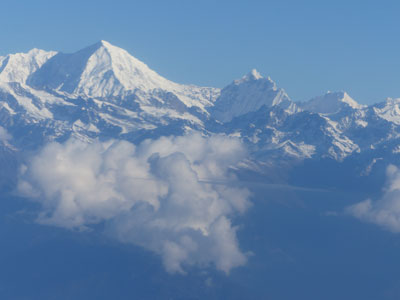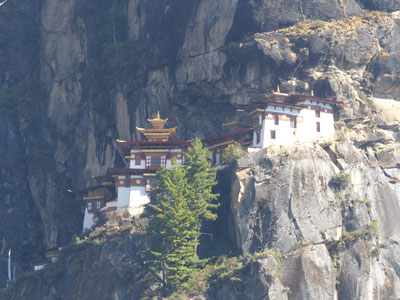Tibet, Nepal and Bhutan – touring the Himalayas
This article appears on page 6 of the May 2015 issue.
A journey on the Qinghai-Tibet Railway had been on my “to do” list since the rail line was completed in 2006, so when a brochure that included not only the train trip but visits to Tibet, Nepal and Bhutan arrived from Worldwide Quest (WQ) in Toronto (800/387-1483, www.worldwidequest.com), I was on the phone within minutes.
Making plans
This “President’s Tour” (Oct. 19-Nov. 6, 2014), led by WQ’s President Lewie Gonsalves, himself, was limited to 18 participants, and I couldn’t afford to miss out.
The base price of $10,395 per person, double occupancy, covered everything except round-trip air from home, but I opted to pay the additional $2,995 single supplement to ensure privacy.
Very little cash was needed once on the trip, since most expenses, including the cost of most meals, were covered, and other extras, such as Wi-Fi or spa treatments, could be paid by credit card.
Most small vendors in all the countries we visited accepted American dollars, so I recommend changing as little money as possible, since it’s difficult if not impossible to change it back.
WQ booked my flights from Cleveland, Ohio, to Beijing and home again from Bangkok for $1,750. I had been to China and Tibet in 1991, so I declined WQ’s optional pre-trip package to see the sights of Beijing, instead booking two nights alone at the Beijing Huabin Fairmont Hotel ($315 per night) to avoid possible problems caused by flight delays and to give myself a chance to settle in.
A visa is required for China, and, as usual, I engaged a visa service, PVS International (Arlington, VA; 800/556-9990, www.pvsinternational.
org), to make things move along. The cost of the visa was $140 plus a $75 fee from PVS, an expense well worth the time and grief it saved.
Finally, travel insurance was required for the trip, so I took out a mid-level-coverage policy with WQ’s provider, CSA TravelProtection, for an additional $1,176. Then I was set to go.
A bumpy start
It’s just as well that I planned to arrive early, since, true to form, my United Airlines flight from Cleveland to Washington Dulles was two hours late, and my flight from Dulles to Beijing didn’t make it at all, causing me to miss one prepaid night at the hotel. (The flight turned back to Dulles after five hours in the air; the pilot explained that the water system wasn’t functioning and that the lavatories would not be usable, so back we went.)
Though we boarded a second flight an hour after arriving at Dulles, our 14-hour flight to Beijing had become a 24-hour ordeal. United has since offered passengers some compensation, but I don’t feel it was enough.
I had originally been scheduled to arrive at around 2 p.m. on Thursday, but I actually arrived at 3 a.m. on Friday. Though I had managed to send an email to WQ alerting them to the delay, I wasn’t sure that my prearranged transfer would be at the airport, so I changed $100 into Chinese currency in case I had to pay a cab. The transfer was there, however, and I was driven to the Beijing Huabin Fairmont Hotel, where I collapsed, exhausted.
I slept most of the next day, and even though I began to recover, I wasn’t tempted to venture out. In the 23 years since my first visit, the air in the major cities of China, especially in Beijing, has become so polluted that you can hardly see across the street.
Getting settled
Our group of 16 gathered Sunday evening for a meet-and-greet dinner in the hotel. As usual, trips like this one draw a self-selecting group: older (mainly retired or semiretired), very experienced travelers with a great fund of stories and a lot of patience.
The next morning we were off to Lhasa, the capital of Tibet, an Autonomous Region of China.
When China invaded and occupied the country in 1951, the Western world barely uttered a whimper. The Dalai Lama was driven into exile in India in 1959, and, today, the status of the country/region is still a bit tricky. Therefore, it is not possible to travel in Tibet alone. Because of the sensitive political situation and the tendency of outsiders to sympathize with the Tibetans, visitors must have permits and travel with guides. Consequently, travelers must be on an approved tour — another reason to use a company like WQ, which engaged both a Chinese guide and a local Tibetan guide for our tour.
In comparison to what I remembered from my 1991 trip, I was astonished by the development of Tibet’s infrastructure and how much its population had grown. Roads, tunnels, condos, shops and so on had sprung up like mushrooms from what was once a single strip connecting airport to town.
Lhasa sits at higher than 11,000 feet, requiring an adjustment for most travelers; shortness of breath and altitude sickness are common. Our itinerary called for a 4-night stay at the lovely Shangri-La Hotel to help us acclimatize.
The hotel was in a beautiful setting and was well appointed, with all the comforts. We were each greeted with a cup of yak-butter tea — a must in Tibet — and a kada, a welcoming scarf placed around the neck, on arrival. The huge buffet offered Western dishes as well as Korean, Chinese and Japanese fare.
Sacred sites
Our first venture was to Potala Palace, the former seat of the Tibetan government and the chief residence of the Dalai Lama until 1959. It is now a museum and a UNSECO World Heritage Site.
Rising 13 stories, it is visible from almost everywhere in Lhasa, dominating the city both architecturally and spiritually. The complex contains more than 1,000 rooms and even today would be an engineering marvel, not to mention at the time it was constructed in the 17th century.
Note that a visit to Potala Palace involves a great deal of climbing, and, given the altitude, it might be difficult.
Coming back down to Earth, we visited Jokhang Temple, which holds the most revered statue of Buddha in all of Tibet.
Outside the temple, the Barkhor, the pilgrim circuit that moves clockwise around Jokhang, is a de facto marketplace where everything from saddle pads to prayer wheels can be purchased (after haggling).
It was a full day and an early night.
The group was driven three hours the next day to visit Lake Yamdrok, one of the three largest sacred lakes in the country, for the view and a picnic. Since I had been there on my last trip, I decided to stay in Lhasa to mosey around by myself.
A home visit had been scheduled at the lake, including photos on a yak, but those who went said that it was painfully obvious how staged it all was.
We next climbed up to visit Drepung Monastery, the largest of all Tibetan monasteries and one of the triad of great monasteries that includes Ganden and Sera. Only about 300 monks maintain the traditions of learning there.
In the afternoon, we were able to view the tradition of debate at Sera monastery, where two monks judge a debate between two others on some point of faith.
Traditionally, monasteries were centers for education. Even though we couldn’t understand the language, we could see the lively, fervent involvement of the participants arguing some fine point.
In the afternoon, WQ had arranged a first-time visit to a school for the blind. Braille Without Borders is run by a Dutch engineer and a German woman who, herself, lost her sight at the age of 13. Over the years, the young couple evolved a curriculum that became the envy even of sighted students, including a focus on fluency in Tibetan, Chinese and English. The initial core of 30 students, both boys and girls, recently boasted their first college graduates.
Riding the rails
The next morning it was time to board the train, which promised to be the high point (literally and figuratively) of the trip.
The Qinghai-Tibet Railway has been the world’s highest train since the inception of its service in 2006. Speeding along the 1,200 miles from Lhasa to Xining, it rises to 16,640 feet at Tanggula Pass (the highest station in the world), pumping oxygen into its specially constructed high-elevation cars until it heads downslope again.
The construction of the line is considered one of China’s great achievements in modern times. Its initial cost was over $4 billion, and a planned extension to Shigatse will increase the bill.
Each compartment holds four bunks, and each bunk has a TV monitor, though I never used mine. Though I had paid a single supplement, I had to share with another woman for the one night of the trip. WQ had arranged for the group to be two to a cabin rather than four, so this was a small inconvenience.
The bunks, themselves, were narrow and uncomfortable, separated by a small table where we could stash our water and snacks.
The train cruised along the plateau, where we saw many yak ranches with hundreds of animals each and enjoyed the timeless picture of people going about their daily business.
Snow-crested mountains lined the route, with wonderful effects from the changing light as the sun moved through the day. Near the end of the route there were even sand dunes.
We gathered in the dining car for a surprisingly good dinner, then settled in for the night.
Unfortunately, many of the Chinese passengers smoked all night in the toilets and in the corridors, despite a prohibition on smoking while oxygen was in use. As soon as we passed Tanggula Pass, everyone seemed to light up, so the air in the cabins was unbreathable. In addition, the toilets soon became filthy.
None of us got much sleep.
In the morning, we had tea and coffee with cookies to keep us going, then left the train at Xining, another city of over two million people, and went to a hotel, where WQ had booked day rooms to give us a chance to shower and rest a bit before our flight to Chengdu.
Panda adventure
We settled into the Sofitel Chengdu Taihe hotel for a good night’s sleep and were ready in the morning for our visit to the 92-acre Chengdu Research Base of Giant Panda Breeding, located about 1½ hours outside the city. It is home to about 50 giant and red pandas.
We were all given coveralls and sturdy gloves, along with rakes, and taken to the empty enclosures to clean them.
We raked up the previous day’s bamboo remnants and other debris, including panda poop, then cleaned the shelters and laid down fresh bamboo.
Finally, we were taken to the kitchen to form panda meal — a special combination of corn and soy meal — into loaves for bread. Not your usual vacation visit!
Later we wandered around, watching the pandas in action. Some were rescued from the wild, while others were bred there. The center has about 10 births per year, but we weren’t able to see any babies in October. Some pandas are released into the wild — where there are only about 1,800 left — and others are rented to foreign zoos.
Our direct flight to Kathmandu the next day was canceled, so we had to fly by way of Lhasa. There were eight flights on this tour, and all but one was late or canceled. However, there is no option but to fly, so you just have to accept it.
Continuing to Kathmandu
Flying into Kathmandu, I was amazed at the size of this capital city, having always thought of it as a small village nestled in the mountains.
We met our guide and drove to Dwarika’s Hotel, a compound straight out of the Raj. I had a huge room and bathroom, a charpoy (bed), a game of bagh chal (also known as the tiger moving game) and a French coffee press; it all made me feel like a real memsahib.
All but one of us opted for the Everest flight the next day (an additional $215), rising at 4 a.m. for tea and cookies to sustain us until we returned. We were very lucky that the weather was clear, enabling our turboprop from Yeti Airlines to take us on this otherworldly adventure.
Each passenger had a window seat, so everyone was able to see everything, and we were given foldout maps of the mountain range. Our flight attendant came through the cabin to point out the different peaks, and we all were allowed to visit the cockpit, individually, to get yet another view.
After breakfast back in Kathmandu, we traveled by bus three miles to the neighboring city of Patan, separated from Kathmandu by the Bagmati River.
The four corners of this ancient city are grounded by stupas said to have been built by the great Buddhist emperor Ashoka around 250 BC.
The heart of the city is Durbar Square, situated at the conjunction of the four main routes leading into the city. Lining the entire eastern side of the square, the Royal Palace Complex has been renovated and now houses the Patan Museum, one of the most important museums in Asia.
Of approximately 1,100 objects in the national collection, some 200 were selected for permanent exhibition, mainly sculptures of Hindu and Buddhist deities from Nepal, India, Tibet and the western Himalayas.
After lunch we visited Boudhanath Stupa, a commemorative monument housing sacred relics. At 120 feet in diameter and a slightly greater height, it is one of the largest and most significant Buddhist monuments in the world and has been a World Heritage Site since 1979. Pilgrims come from all over the Himalayas and East and Southeast Asia to walk under the huge, all-seeing eyes of the Buddha.
Dozens of shops surround the stupa selling souvenirs, food and everything else.
Our guide promised us some free time to walk around, but, instead, he took us to a monastery to witness a puja ritual, complete with horns, incense, music and chanting.
On to Chitwan
Before our morning flight to Chitwan the following day, we went to the temple of Pashupatinath, one of the most important Shiva temples on the subcontinent and a significant pilgrimage site. We watched as a family prepared their father for cremation, the sons and daughters, dressed in simple white garments, oiling the body and showing all due respect.
The cremation site was near the temple, and the ashes of the cremated bodies are sprinkled on the waters of the Bagmati, considered holy by Hindus and Buddhists.
After a delay, we boarded our 15-minute flight to Chitwan, Nepal’s first national park. The trip by road, incidentally, would have taken six hours.
At Chitwan, we drove about an hour on a gravel road to Kasara Resort, where we were welcomed by the resident elephants, painted with welcome messages.
My room was large and included two shallow pools in the foyer. It was restful — and a particular delight — to watch the tiny water frogs jump from rocks to plants in the pools.
After a poolside lunch, we were off for our elephant trek through the park, lurching side to side in our howdahs. In the space of our 2-hour ride we saw nine one-horned rhinos, not to mention hog deer, wild boar, storks, dozens of egrets and kingfishers.
The one-horned, or Indian, rhino came close to extinction in the early 20th century due to poachers seeking to sell the horns as an aphrodisiac in China. Since being protected, their numbers have risen to about 3,000.
One of the benefits of traveling on elephantback is that the animals, as a regular part of the landscape, don’t cause the kind of disruption a motorized vehicle does. The rhinos we saw — a mother and her small baby, a mother and an older baby, a male and a female — certainly responded to our presence, but they didn’t seem especially perturbed.
On our trek, we passed through the nearby villages. It was harvesttime, and farmers were driving their bullock carts to and from the fields. Smoke drifted off the outdoor fires used for cooking, and every courtyard was swept clean.
It’s easy to romanticize such places, but I must say that the mood of quiet contentment, the relaxed feeling of things moving at their own pace, was very attractive.
After our ride, we enjoyed a naturalist’s slide show describing the area’s flora and fauna. The combination of sal wood, grasslands and riverine forests creates quite a different jungle from that of the Amazon, for example.
More wild encounters
Our next day brought a “cruise” down the Rapti River in a dugout canoe of magnolia wood, during which we admired the flycatchers, storks, brown herons and egrets along the banks.
We stopped at the Gharial Breeding Centre to observe these narrow-snouted, fish-eating crocodiles. We saw everything from tiny babies to much larger, older crocs ready to be released into the wild.
The afternoon featured an exhibition of elephant bathing, and we were invited to join in. The main purpose of the exercise is, of course, to give the elephants a welcome break, but the secondary purpose is to make sure visitors get as wet as possible! It was all great fun, as a half dozen members of our group joined the elephants in the river.
The most fun, by far, was had by a baby elephant, who rolled and ducked and just plain gloried in the cool, brown water.
Our second jungle safari, this time in a jeep, was not as much fun as the elephant trip, and we saw very few animals.
Before our departure the next morning, we had one last elephant ride through the nearby village, and I was sorry to leave this serene place.
Bhutan
After flying back to Kathmandu for an overnight stay, we were off to Bhutan. The 1½-hour turboprop flight took us to the beautiful Paro International Airport.
The government requires all buildings to be constructed and decorated in the old Bhutanese style, and the airport’s main terminal was no exception, making a lovely introduction to Bhutanese culture.
An hour’s drive took us to the capital, Thimphu, and the Taj Tashi Thimphu, a beautiful, comfortable hotel likewise constructed and decorated in the old style while offering 5-star amenities.
Bhutan receives 100,000 visitors a year (up from just 2,500 a decade ago), so there is a great deal of concern about preserving the indigenous culture. Along with traditional architecture, traditional costume is required. Men wear the kimono-like gho and women, the long-skirted kira.
Our visit to Bhutan coincided with that of the head of the Indian armed forces, and we were diverted around his party. When we visited a large stupa dedicated to the late king, H.M. Jigme Dorji Wangchuk, the founder of modern Bhutan, we became aware of busy preparations and crowds circling the stupa and turning prayer wheels.
Bhutan enjoys a very close relationship with India, though it maintains its sovereignty. When China snapped up Tibet, Bhutan became aware of its vulnerability, despite being enclosed by mountains, and began to bolster its relations with its powerful southern neighbor, to which it sells hydroelectric power generated by its many rivers.
As we watched the Indian party pay respects at the stupa, I was suddenly surrounded by a group of 11-year-old schoolgirls wanting to practice their English. Dressed in traditional kiras, they were part of a choral group that would provide entertainment later on.
Their English, like that of our guide, was remarkable. Fluent and colloquial, it was evidence of the focus placed on education as Bhutan interacts more with the modern world.
Unscheduled surprises
I had been reading about the takin, Bhutan’s national animal, said to have a goat’s head on the body of a cow. When I asked where it could be seen, our guide made a detour past the Motithang Takin Preserve, where many are kept.
As a species, the Bhutan takin is vulnerable — only 200 to 300 are left in the wild — because they are deemed to have medicinal and aphrodisiac value. Though cursed with a face only a mother could love, they are endearing animals, herbivores who chomped greedily at the holly passed through the fence by our guide.
On our way out of town, we stopped at the post office so anyone who wanted to could send postcards back home. In fact, the office will make stamps featuring your own picture while you wait. These are perfectly valid postage stamps and, I imagine, would give quite a surprise to friends receiving them.
Paro finale
Our hotel in Paro, the Zhiwa Ling, was the loveliest in a long series of beautiful hotels on our trip. Our rooms were located in buildings separate from the main structure, which was elaborately decorated in colored carved wood.
Antiques were placed throughout the lobby area, and a shop selling souvenirs, mostly textiles, was in the lobby. DESCRIPTION of the mountains, it did look like a vision of Shangri-la.
Our final day involved a hike to the iconic Taktsang Monastery (Tiger’s Nest). It is the landmark most associated with Bhutan, the monastery hanging from the side of a cliff 2,600 feet above the floor of the Paro Valley.
The steep path led the group first to a teahouse, then up to a vantage point above the monastery (the point from which all the famous photos are taken), then down 500 steps and back up 250 to the monastery.
Almost all of our group made it (I couldn’t climb even to the teahouse), but some felt the effects the next day. Even though Paro and Thimphu are at a much lower altitude than Lhasa, the thin air still does take its toll.
Small horses are available to ride to the teahouse, but they were not in particularly good condition, so I refused to ride. Their hooves were not properly trimmed, and they looked like they had never been groomed, much less seen a veterinarian. Like the dogs seen all around, they had had minimal care.
In the afternoon, still another dzong (monastery) was to be featured, but by this time most people had been monasteried out, so very few people went.
We had our farewell dinner at the hotel, then had an early night.
We flew the next day to Bangkok, where some of the group began to disperse for other destinations. Most of us overnighted at the Novotel Suvarnabhumi Airport Hotel, an entirely new, modern hotel located just across from the terminal. The facilities and staff were excellent.
Returning home, I could hardly believe all that I had seen and done on this trip. It was like a dream! From all points of view — introduction to exotic cultures, variety of adventures, excellence of hotels, guides, itinerary and arrangements and so on — this was a journey that made me feel that I finally had a grasp of a part of the world I’d only read about, the Himalayas.

